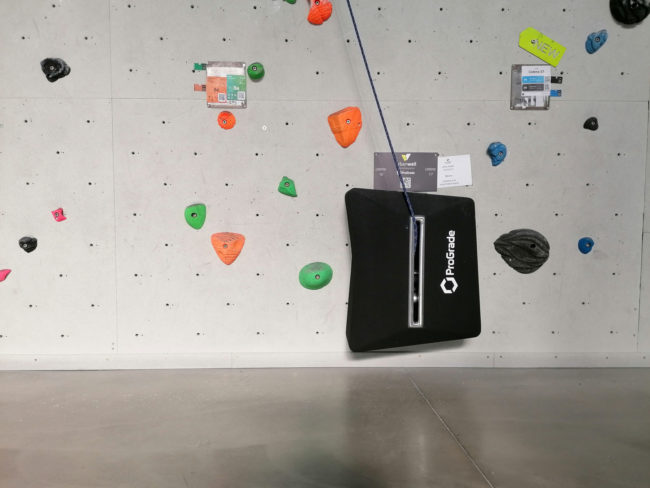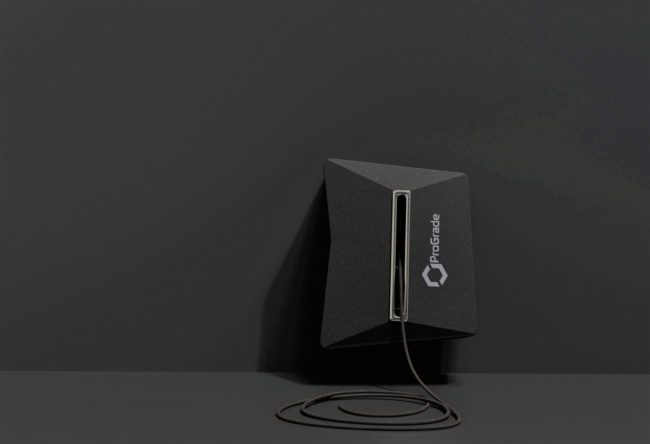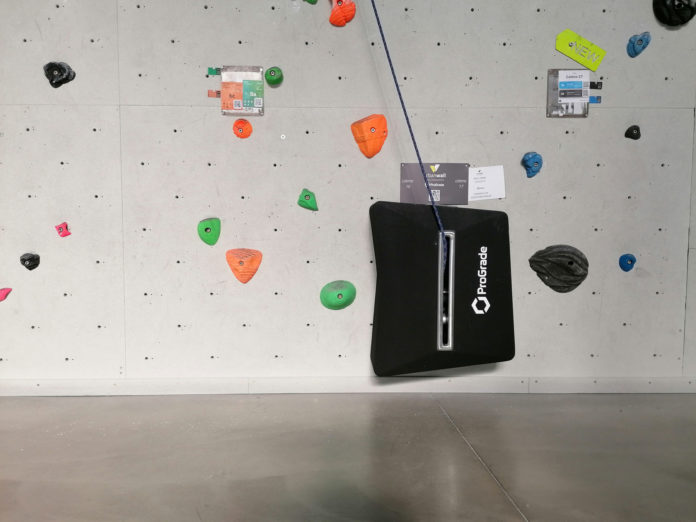
On the heels of TRUBLUE unveiling its innovative catch-and-hold auto belay last month, a company in Italy, ProGrade, has released a new auto belay that can be utilized for lead climbing—essentially allowing appropriate slack for clipping into quickdraws during an ascent.
The new ProGrade “lead-ready auto belay” is not the first device in history to combine lead capabilities to the auto belay concept; for example, a German company, Auroco, publicized a “portable lead climbing auto belay device” in 2016 that was deemed a “game changer” by Climbing magazine at the time. But ProGrade’s new lead auto belay is among the first of its kind to be used in commercial indoor climbing. Furthermore, unlike Auroco’s device in 2016, which never made big inroads into the American gym market, the new ProGrade device could eventually enter the American climbing industry.
“We are currently working on the creation of an international sales network with the help of partners and distributors,” one of ProGrade’s engineers, Alessandro Maneo, told CBJ. “Given our very recent market launch, we are not yet ready to sell it in the US—but given the great appreciation and response from the market, it is possible that this step will happen faster than expected.”
The “recent market launch” that Maneo speaks of was ProGrade’s lead auto belay installation at a gym called UrbanWall on September 15th in Milan, Italy. In the first week of the device’s operation and availability within that gym, the ProGrade engineers recorded approximately 700 uses by customers—which equates to more than 100 uses per day—and actively collected comments and feedback.
Maneo notes that UrbanWall patrons were by-and-large complimentary of the ProGrade lead auto belay device: “Even the most skeptical who initially did not want to try it in the end were convinced and were satisfied with the experience,” said Maneo, adding that the ProGrade auto belay possesses CE safety certification (the EU’s standard for machines), and has been tested according to the UIAA’s canonical regulations for climbing by a certification body known as Dolomiticert.

The development of the ProGrade lead auto belay traces back four years, when three Italian engineers frequented the UrbanWall gym but were frustrated by the long wait times between climbs. Such gridlock prompted two of those engineers, Maneo and Filippo Bollini, to found ProGrade—and soon it also prompted market research, customer surveys, even a prototype of the lead auto belay constructed from 3D-printed components and household appliance parts. Amid this, the owner of UrbanWall, Mario Invernizzi, became a lead business partner, not only sponsoring the adoption of the ProGrade lead auto belay in his Milan gym, but also funding the bulk of the project and providing initial feedback.
If the origin was decidedly grassroots, the end product is anything but simplistic. The inside of ProGrade’s lead auto belay—the result of those four years of research and development—contains a sensor that “reads the movements of the rope,” which corresponds to internal software that is specifically designed to “recognize in real-time the actions of the climber,” Maneo explained. Internal motors that allow for rope winding (and unwinding) are controlled by the software, but the locking system is entirely mechanical and works by rope friction, not dissimilar from other auto belay systems that have proven popular in gyms over the years.

In essence, ProGrade’s internal software and mechanics are able to work in conjunction (“balancing safety and comfort,” according to Maneo) to detect how far a climber is from the ground—not only to allow for appropriate slack in the rope, but also to avoid ground falls. Maneo also notes that slack can be retrieved by the ProGrade device at a rate/speed much quicker than a human belayer could do.
According to the engineers at ProGrade, the lead auto belay bolts to the base of a climbing wall. In most cases no specific wall modifications would be needed in an average gym, and a bracket on the back of the climbing wall connects the device to the floor.
The ProGrade’s American MSRP and US availability will depend on the Euro/USD exchange rate and import taxes that are yet to be fully calculated, Maneo said. ProGrade’s contact information for inquiries can be found on ProGrade’s website, and the company can be followed on Instagram: @prograde_official.

John Burgman is the author of High Drama, a book that chronicles the history of American competition climbing. He is a Fulbright journalism grant recipient and a former magazine editor. He holds a master’s degree from New York University and bachelor’s degree from Miami University. In addition to writing, he coaches a youth bouldering team. Follow him on Twitter @John_Burgman and Instagram @jbclimbs. Read our interview Meet John Burgman, U.S. Comp Climbing’s Top Journalist.








